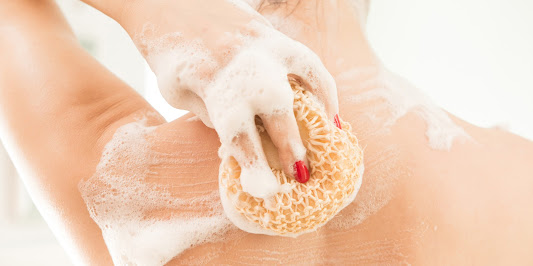Petrolatum - Moisturizer or Gasoline?
 |
| Steve Calcott. Soothing; 2006. |
Vaseline is common product in most households, but have you ever wondered what it actually is? It goes by many different names such as petroleum jelly and mineral grease, but the name that you will most likely see on the ingredients list of your products is petrolatum [1]. Basically, this semi-solid substance is made up of a bunch of different hydrogens and carbons bonded together to give it it’s jelly-like texture; but how did it get to be this way [2]?
Before petrolatum becomes the Vaseline we know and love, it begins as crude oil [2]. Crude oil is a type of fossil fuel that undergoes a refining process in order to separate it into its various components [2][3]. To do this, crude oil is added to a large distilling tower where the temperature is slowly increased [2]. At each rising temperature point, various compounds are boiled off until eventually all that is left is the final product, petrolatum [2].
This petrolatum product has no odour and has a melting point close to human body temperature which makes it an ideal product for moisturizers as it melts right into the skin [4]. It is also insoluble in water, so it traps all of the skin’s natural moisture in as well [4]. This property of petrolatum is also handy when dealing with cuts and burns as it keeps all of the disease-causing organisms out of the wound while it heals [4]. These features make petrolatum the ideal substance to use in hair conditioners, face creams, antiperspirants, sunscreens, and even candles, but some people are concerned as to how safe this chemical actually is [4].
Because crude oil can also be refined into gasoline and other industrial forms, it needs to be properly refined in order to remove the toxic chemicals that are found in these other substances [5]. These chemicals are called polycyclic aromatic hydrocarbons (PAHs) and they have been known to cause cancer [5]. In order to determine the quality of the petrolatum, a full refining history of the product needs to be analyzed; however, these are not readily available in the United States which causes some concern for individuals [5]. Without PAHs, petrolatum has a very low toxicity and is not suspected to be a cancer-causing agent; and companies who use petrolatum for cosmetic purposes are using quality materials so there should be no cause for concern [6]. Overall, petrolatum is a safe and reliable product that is very versatile and is likely in many of the skin care and cosmetic products you’ll find at home.
References
[1] Law, J.; Rennie, R. (2020). Petrolatum. A Dictionary of Chemistry (8th edition). Retrieved from https://www-oxfordreference-com.libproxy.mtroyal.ca/view/10.1093/acref/9780198841227.001.0001/acref-9780198841227.
[2] Petrolatum. (2021). Encyclopedia.com. Retrieved from https://www.encyclopedia.com/science-and-technology/chemistry/organic-chemistry/petrolatum.
[3] Chen, J. (2020). Crude Oil. Investopedia. Retrieved from https://www.investopedia.com/terms/c/crude-oil.asp.
[4] Petrolatum. (2017). Chemical Book. Retrieved from https://www.chemicalbook.com/ChemicalProductProperty_EN_cb9854422.htm.
[5] Petrolatum, Petroleum Jelly. (2015). Campaign for Safe Cosmetics. Retrieved from https://www.safecosmetics.org/get-the-facts/chemicals-of-concern/petrolatum/.
[6] Material Safety Data Sheet. (2012). Fougera Pharmaceuticals Inc. Retrieved from https://safety365.sevron.co.uk/substances/accessSDS/SDS-11225-59ccb8051f7dd5.10515458.



Comments
Post a Comment